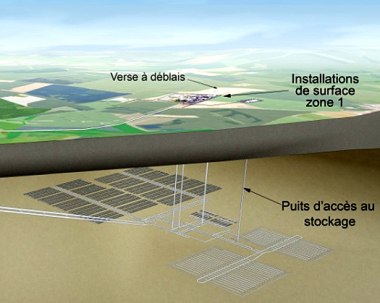Next phase for French geological disposal
05 January 2012
Industrial design work is set to begin for a deep geological repository for France's high- and intermediate-level radioactive waste following the signing of a contract between French radioactive waste agency Andra and a joint venture of two engineering companies.
 |
Cigeo's underground operations will ultimately occupy 15 km2
(Image: Andra)
|
Andra has signed a six-year contract with Gaiya, a joint venture of Technip and Ingérop, as main contractor to project manage the conceptual and front-end phases of the Centre Industriel de Stockage Géologique project, dubbed 'Cigeo'. The facility will provide final storage for the most radioactive of France's waste, mostly from its nuclear power plant operations and used fuel reprocessing. The first conceptual study phase is to be conducted during this year and will lead on to a public consultation that will take place in 2013.
The signing of the project management contract concludes a phase of study and research set in motion by France's 1991 Waste Management Act. In 2006, the act was updated to formally declare deep geological disposal as the reference solution for high-level and long-lived radioactive wastes, making Andra responsible for the design and establishment of a repository with target dates of 2015 for licensing and 2025 for operations.
The Cigeo project will see the development of a storage facility at a depth of some 500 metres, located in the Meuse/Haute Marne area in eastern France where Andra has already conducted extensive geological and scientific studies in the Bure underground laboratory. The facility will exploit the properties of the Bure clay formation as a geologic barrier to prevent any potential spread of radioactivity. Although Cigeo will be designed to accommodate the wastes permanently, French law requires that storage can be reversible for at least 100 years.
Cigeo's surface facilities are envisaged as occupying approximately 300 hectares, spread over two sites a few kilometres apart. Underground storage facilities will be developed in a modular fashion, eventually extending to 15 square kilometres. The facility is anticipated to operate for 100 years before final closure.
The industrial design phase which is now beginning will see the development of designs for the storage facility taking into account all the operational, civil engineering, equipment, organization and site operation considerations throughout its lifetime, as well as estimations of construction time and overall costs, and gathering relevant technical data. During 2012, the anticipated inventories of waste to be placed in the repository will be specified in collaboration with the waste producers (namely French nuclear utility EDF, fuel cycle company Areva and nuclear research and development agency the CEA), while at the local level attention will be focused on planning for the surface facilities and infrastructure development.
Andra plans to launch tenders for contractors to carry out preliminary design studies for surface installations, conventional nuclear surface facilities, waste package handling and and underground facilities in 2013.
Researched and written
by World Nuclear News